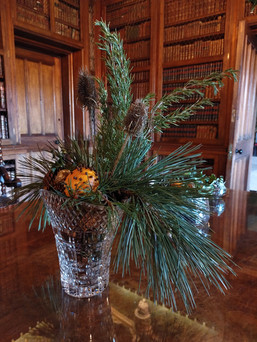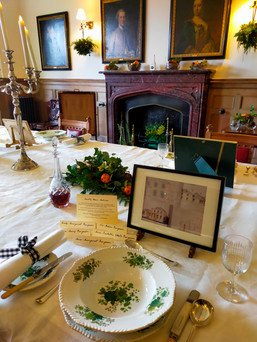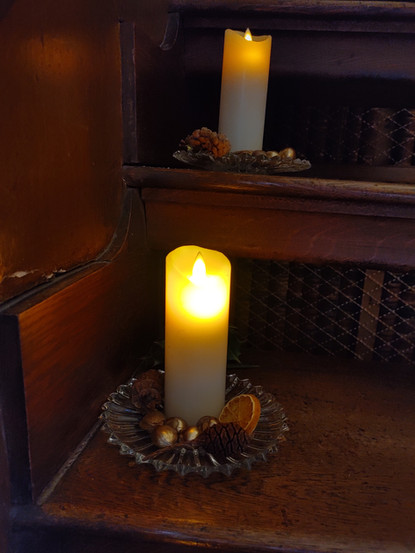An 1820s Christmas with Sir Walter Scott at Abbotsford
- Wee Walking Tours

- Dec 15, 2021
- 4 min read
We have been having so much fun enjoying Edinburgh’s Christmas, but this week we venture further afield to make a day trip south to the Scottish Borders. Specifically, we are going to visit one of our favourite houses in Scotland- Sir Walter Scott’s home, Abbotsford.

Before we get to this week’s festivities, if you haven’t read it already, please be sure to check out our standalone article on Abbotsford if you are interested in learning a bit more about its history and general information.
Last week we undertook a little time travel to the 1500s and explored how Mary Queen of Scots celebrated Christmas at the Palace of Holyroodhouse. Now, we jump ahead a few centuries to learn how Sir Walter Scott celebrated the joyful season in the 1820s. The year is 1823 and Walter Scott and his wife, Charlotte, are looking forward to leaving the cacophony of Edinburgh to celebrate the holiday season at their beloved Abbotsford.
Now, as I discussed in the Mary at the Palace post, Christmas was already shunned by the Protestants during Mary's time and later banned in Scotland in 1640. That law was repealed in 1712, but even after, the Church of Scotland still strongly discouraged Christmas celebrations. In Scotland, this period was known as ‘the daft days’ which was a term coined by another famous Scots writer, Robert Fergusson, in his poem, ‘The Daft Days’. This was due to the tradition of it being a time of merriment, festivities, and, yes, often excess (which is why it was frowned upon so much by the rather austere Presbyterian Church of Scotland after the Reformation).

Nevertheless, in the 1800s, families still enjoyed the holidays- especially in their homes. Specifically, this comprised the 12 days of Christmas-from the 25th of December until the 6th of January as well as Auld Handsel Monday (the first Monday of the New Year); the latter being an especially important holiday for the Scottish working class.
The word ‘Handsel’ originates from old Saxon and means ‘to deliver into the hand’. In Scotland, on Auld Handsel Monday, gifts or tokens (handsels) were given to servants, employees, and children. Interestingly, the Presbyterian Church seemed to tolerate this holiday more over Yule/Christmas which they thought of as pagan (how Yule originated) and too Catholic. According to Abbotsford, in 1824, over ‘200 children from Galashiels to Melrose’…would “gather at the back door to gather their prize- an oatcake and a penny”.
Other traditions that were part of Mary Queen of Scots’ time continued over the centuries. This included decorating with items from nature- which has always been in abundance at Abbotsford. The gardens and surrounding grounds are stunning, and Walter Scott loved spending time outdoors. The family could enjoy relaxing walks along the River Tweed or stroll through the lush forest. It would be quite picturesque during the holidays in 1823/1824 with the snow blanketing the trees and crunching under foot (you'll have to use your imagination when looking at the photos below).
Therefore, it is only fitting that Lady Scott made sure to bring a little bit of this natural oasis inside the house. As you walk through Abbotsford, there is a festive aroma in the air as pinecones, branches, holly, and oranges studded with cloves are set up throughout the house.
The grand space of the library will be the scene of Abbotsford’s first winter ball. What an exquisite room for guests to glide around as they dance to familiar songs of the season.

Abbotsford describes how Walter Scott thought of his family as “his little clan”. He doted on them, and the house is filled with reminders of the Scott family. In the library, a painting of Walter Jr. stands pride of place in the centre of the room above the mantel. Caroling within the home was another merry custom that was part of the family's Christmas. If I close my eyes, I can practically imagine them gathered round the fire, singing, and enjoying each other’s company.

In the drawing room, you can really feel the refined and elegant taste of Sir Walter’s French-born wife, Charlotte. The holiday season was quite meaningful to them as they were married on Christmas Eve 1797. Their youngest daughter, Ann, was the image of her mother and there is a lovely painting of her in the drawing room dressed in an opulent Spanish dress of crimson and gold.


As we make our way to the dining room, listen carefully- can you hear the melodic sounds of the bagpipes? The room is set up for the first dinner party of ‘these daft days’. Sir Walter, with his never-ending love of Scottish culture, has John Bruce of Skye playing his pipes for the dinner guests.
There is so much more to take in throughout the house. Therefore, please enjoy this slideshow to experience more of Abbotsford’s 1820s Christmas celebration:
Well, unfortunately, our brief tour of an 1820s Christmas at Abbotsford has come to an end. If you have enjoyed it, and will be in the area this holiday season, be sure to take the time to make a visit to Sir Walter Scott’s ‘conundrum castle’. It’s a fantastic way to celebrate the 250th anniversary of his birth and the holiday season all in one (speaking of celebrating his 250th at Abbotsford- we had a grand time this past summer at ScottFest)! Best of all, all entry tickets to the house, chapel & gardens are currently half price thanks to Visit Scotland’s Great Days Out in Scotland scheme. However, Abbotsford highlights that this is only available while offer lasts. Be sure to go to their website to book your tickets and for the most up-to-date information.

Lastly, I’m happy to share that canine family members are welcome in the Visitor Centre, gardens, and grounds (obviously not the house- which is not a surprise if you look closely at wee Stirling’s undercarriage in the photo below 😂😬). Finn, Sawyer, and Stirling had a fantastic time exploring the grounds which are a peaceful refuge from the busy city for both humans and dogs.
Until next time- Explore & Discover!






































































